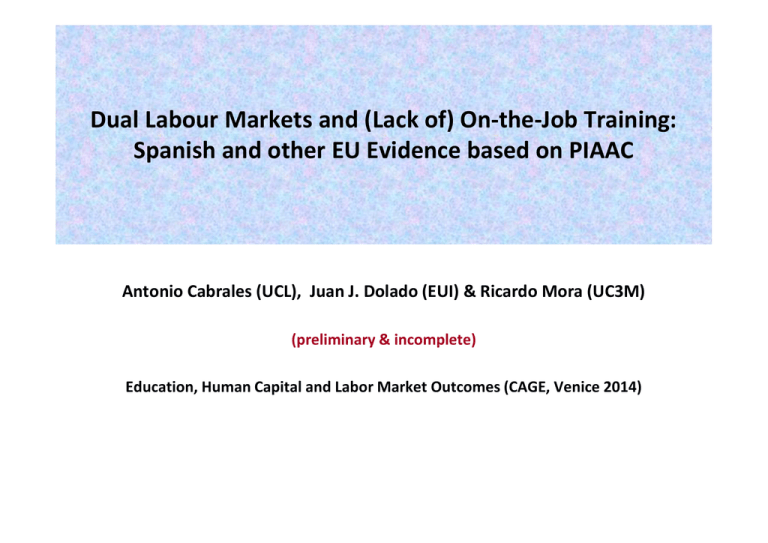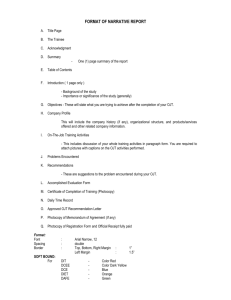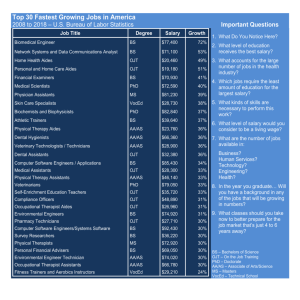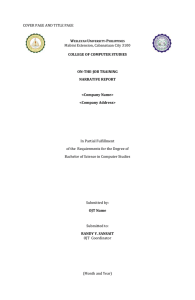Dual Labour Markets and (Lack of) On-the-Job Training: (preliminary & incomplete)
advertisement

Dual Labour Markets and (Lack of) On-the-Job Training: Spanish and other EU Evidence based on PIAAC Antonio Cabrales (UCL), Juan J. Dolado (EUI) & Ricardo Mora (UC3M) (preliminary & incomplete) Education, Human Capital and Labor Market Outcomes (CAGE, Venice 2014) Outline Motivation & Research question Illustrative model PIACC design Descriptive stats Empirical results (Spain, EU reference countries ) Conclusions Motivation & Research question Large literature on the effects of the overall level of Employment Protection (EPL) on On-the-Job Training (OJT) [Favourable ( Lagos, 2006, Belot et al. , 2009) vs. Unfavourable (Saint-Paul, 2002)] Less research on the effects of Dual EPL (Perms-Temps) on OJT. [Favourable (Stepping Stones, Booth et al. , 2002) vs. Unfavourable (Dead Ends, Dolado et. al, 2002, 2013)] Available evidence focuses on country specific studies or crosscountry studies based on ECHP (1994-2001). [Aralumpanam et al., 2004, Booth et al., 2002, Bassanini & Brunello, 2011] PIAAC provides a more updated and harmonized sample to test the relationship between fixed-term contracts, OJT and lifelong learning Focus on Spain relative to (some) EU reference countries with similar and less segmented LMs Why Spain ? ↑ 100 80 60 40 20 0 15 20 Up to 20 25 y.o. 30 21-25 35y.o. 40 26-3045y.o. Age y.o. 50 31-3555 60 Dualism is a major concern We will offer you a contract for 5 minutes and then we will see... ..I am fired every 3 months…then am on the dole for 6 months, get rehired for another 2 months... What a mess!!… What´s your job ? No clue, I have only been in the labour market for 3 years Labour contract dualism & OJT & Proficiency Dual LM → OJT → Proficiency ? Dual LM (Temps vs. Perms) • Dual LM & Training Theories: Temps get less OJT due to: (i) Higher turnover- Low temp-to-perm conversion rates (ii) Lower union coverage (iii) Concentration in lower value-added industries • Training & Proficiency: Lifelong learning → ProducAvity PIAAC Design Programme for the International Assessment of Adult Competencies (PIAAC_OECD): measures level and distribution of skills among adult populations (15-65) in 22 countries (1st wave), plus utilization of skills in different contexts. Previous programmes focused on specific age groups: PISA (15), PIRLS-TIMMS (10-12), etc. PIACC evaluates proficiency in literacy, numeracy (+ problem solving in IT-rich environments: not evaluated in Spain) Scores ∈[0, 500] Six levels of proficiency <L1:<176, L1:176-226; L2:226-276; L3: 276-326; L4:326-376; L5:>376 Standarized tests (about 1.5 h. long each)– sep. 2011-may 2012Spanish sample: # 6055 individuals Participating countries (1st Round) → → → Available info in PIAAC Demographics Age, Gender, Nationality, Civil status, Children, Parental education Labour status, education & training Educational attainment, Labour status, Type of contract, Job tenure, Wage, On-the-Job Training, Motivation Focus: FT Employees : # 2513 individuals Caveat: Cross-section, Lack of natural experiment Approach: Wide set of controls to avoid omitted variables bias A simple model • Two periods (p1, p2) • Ability (= productivity) : uniform dn. • Firms (may) provide OJT in p1. Productivity of trained workers rises from θ to ζ=hθ, with h>1, in p2 • Cost of training is decreasing in θ: C(θ) = , k>0 • Untrained workers (u) produce θ in both 1 and 2 Trained (t) workers (t) produce in 1 and in 2 • Contracts: Perm (P) jobs involve firing cost F>0; Temp (T) jobs don´t • Quit rate in T jobs : q∈[0, 1] • In t=2, productivity shock ε (BC) hits s.t. that perceived ptvy dn. becomes Note: ε ↑1: Recession; ε ↓0: Expansion • Posted wages in t=1 and paid in t=2 t=1 t=2 --------------------I-----------------------↓ Training ↓ Shock , Quit , Pay Asset values of firms: Perms ) Temps Under a uniform dn. for shocks → Perms Temps Asset values of workers (Vi >0) Trained Untrained Similar but with instead of Decisions on OJT (Productivity thresholds, Firms offer OJT whenever: Perms OJT for Perms: increasing in F Temps OJT for Temps: decreasing in q ) OTJ gap between Perms and Temps Descriptive stats Outcomes of interest Receiving OJT (binary) OJT Intensity [Probit] [Neg. Binomial] Need of more OJT (binary) [Probit] [OLS] Main treatment: TC Share of Temporary Contracts by Age 60 50 40 30 20 10 0 15-25 26-30 31-55 +55 When Temporary contract becomes an additional control, its coefficient turns out to be insignificant and the results on OJT hardly change Numeracy scores DOJT [1] [2] [3] [4] 7.0548*** --- 5.3412*** 3.4651*** (1.7143) (1.6912) --- --- (1.7215) nOJT --- 0.2693 (0.1655) Temporary contract -0.0365 -0.0843 -0.0728 -0.0652 (0.0956) (0.0951) (0.1094) (0.1115) Reference countries • Other Dual LMs (FR, IT) • Less Dual LMs (DK, UK) • Indicators of LM Dualism (i) Perm-temp EPL Gap (5 yrs PC vs. 5x1 yr.TC) (Doing Businnes, 2014, Boeri et al., 2013) (ii) Temp-Perm conversion rates (OECD, 2013, EC , 2013, ELFS) Conclusions For the typical worker with a permanent contract, switching to a temporary contract is associated with a reduction in the probability of receiving OJT by 18 % (= -0.08/.44). Ceteris paribus, the availability of OJT accounts for: 15 % (2 pp./14.2 pp.) and 28% (5 pp./18.6 pp.) of the raw score gaps in literacy and numeracy, respectively. Reference countries (FR, IT) with Dual LMs show similar patterns but those with more unitary LMs (DK, UK) differ. We abstain from making causal statements but the evidence is suggestive of a plausible causal mechanism. Thanks for your attention





